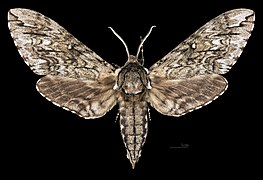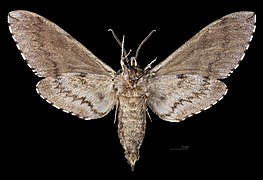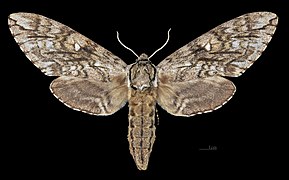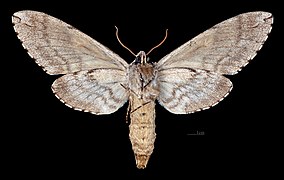Ceratomia undulosa
| Ceratomia undulosa | ||||||||||||
|---|---|---|---|---|---|---|---|---|---|---|---|---|
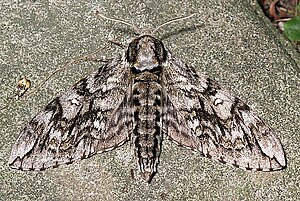
Ceratomia undulosa |
||||||||||||
| Systematics | ||||||||||||
|
||||||||||||
| Scientific name | ||||||||||||
| Ceratomia undulosa | ||||||||||||
| ( Walker , 1856) |
Ceratomia undulosa is a butterfly ( moth ) from the family of moth (Sphingidae). The species is one of the most common swarming species in eastern North America.
features
The moths have a fore wing length of 40 to 48 millimeters. The color of the moths is variable. Individuals from the north of the range are rather very dark, with reduced white markings. Individuals from western Pennsylvania and eastern New York are often melanistic and therefore almost black in color. Animals from southwest Texas tend to have little contrasting gray. There are also light yellowish brown individuals. The species can be confused with Ceratomia catalpae and Ceratomia hageni . However, one can easily distinguish them from the former type by the forewing pattern. The pattern of Ceratomia undulosa almost always consists of strongly contrasting gray tones, white and black. There is also a clear white medial line and a white discal spot on the upper side, as well as a white band on the outer edge. In Ceratomia catalpae the pattern is covered by a dull brown color and the white elements are missing. Ceratomia hageni only has the white discal spot and the white border, the remaining white elements are also missing. The white median line is replaced by a dark one in this species, whereby the submarginal area and the wing tip are also drawn in white. The hind wings of Ceratomia undulosa are gray with indistinct dark bands.
The caterpillars are quite variable. Their basic color ranges from light green to dark brown and there are many individuals who are spotted with these in color combinations. The back is usually darker in color than the belly side. The caterpillars have a long, slender body with a conspicuous anal horn . On the sides they have seven white diagonal stripes, which lead from the front of the respective segment at approximately the level of the spiracles to the back of the following segment. The body of the animals is very smooth. Caterpillars that are ready to pupate take on a pink color.
The pupa is similar to that of Ceratomia sonorensis . It is almost black and has a dark brown sheen at the ends of each abdomen segment. Their surface is a bit rough. The trunk sheath is fused, the short, very wide cremaster ends in a double point.
Occurrence
The species has a similar distribution in North America as Ceratomia amyntor , but the distribution area is larger. In the east, the species is found from southern Florida north to Corner Brook in Newfoundland. It occurs in the entire center of the continent from west Texas to northeast Utah, east Montana to the foothills of the Rocky Mountains in Alberta. In Canada it is distributed from Prince Edward Island and Nova Scotia to eastern Alberta.
Ceratomia undulosa inhabits dense forest areas with ash vegetation . Like Ceratomia amyntor , the species is common in the east, but only locally distributed in the west.
Way of life
The moths often fly to light sources at night. Although the proboscis is only about 11 millimeters long, it can be assumed, despite poor documentation, that the species can take in food, especially since the necessary muscles are developed. Other sources mention suction trunk lengths of up to 30 millimeters.
Flight and caterpillar times
The moths fly pretty much across the entire range from late May to mid-July. In eastern Ontario, two maxima can be seen in mid-June and mid-July, although bimodal flight times are otherwise not known for swarmers. In Louisiana, the species flies in several generations from March to September.
Food of the caterpillars
The caterpillars feed mainly on ash trees ( Fraxinus ), but they have also been found on privet ( Ligustrum ) and Chionanthus virginicus , which also belong to the olive family (Oleaceae). There is also evidence of oak ( Quercus ) and hawthorn ( Crataegus ).
development
The females lay their pale green, medium-sized eggs individually on the underside of the host plants. The caterpillars hatch after about eight days. Pupation takes place in a chamber a few centimeters deep in the ground.
supporting documents
Individual evidence
- ↑ a b c d e f g h i j k l James P. Tuttle: The Hawkmoths of North America, A Natural History Study of the Sphingidae of the United States and Canada. The Wedge Entomological Research Foundation, Washington, DC 2007, ISBN 978-0-9796633-0-7 .
- ↑ a b c d e f g Sphingidae of the Americas. Bill Oehlke, accessed December 28, 2011 .
literature
- James P. Tuttle: The Hawkmoths of North America, A Natural History Study of the Sphingidae of the United States and Canada. The Wedge Entomological Research Foundation, Washington, DC 2007, ISBN 978-0-9796633-0-7 .

